Abstract
A single administration of the inhibitor of protein synthesis cycloheximide results in the occurrence of apoptosis in rat liver. The presence of intracellular apoptotic bodies was detected as early as 2 hours after treatment. No evidence of cell necrosis could be observed by histologic and biochemical analysis. Apoptosis was followed by an increased expression of testosterone-repressed prostate message-2 RNA, a gene whose activity has been associated to apoptotic cell death in involuting rat prostate. The finding of in vivo induction of apoptosis in nonproliferating cells by an inhibitor of protein synthesis, together with the rapidity and synchrony in the occurrence of cell death make this model potentially useful for the analysis of the kinetics of the apoptotic cycle and in exploring some of the mechanisms of regulation of genes possibly involved in this type of cell death.
Full text
PDF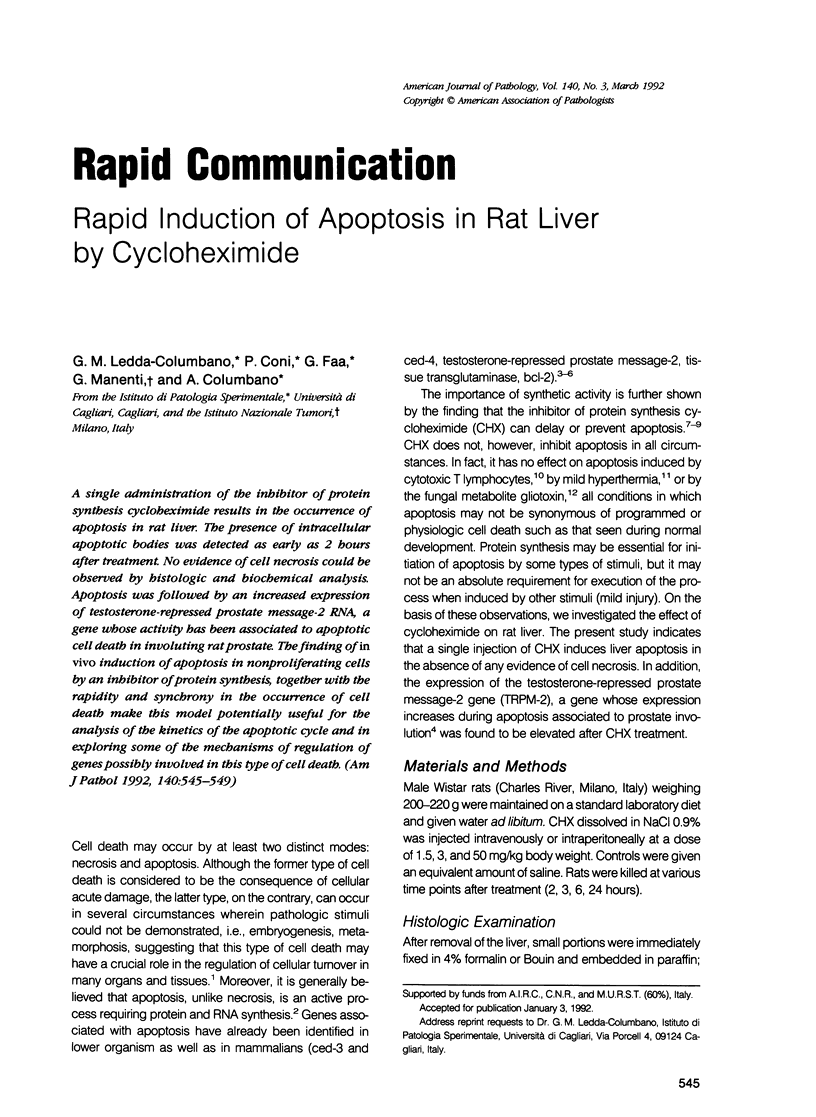
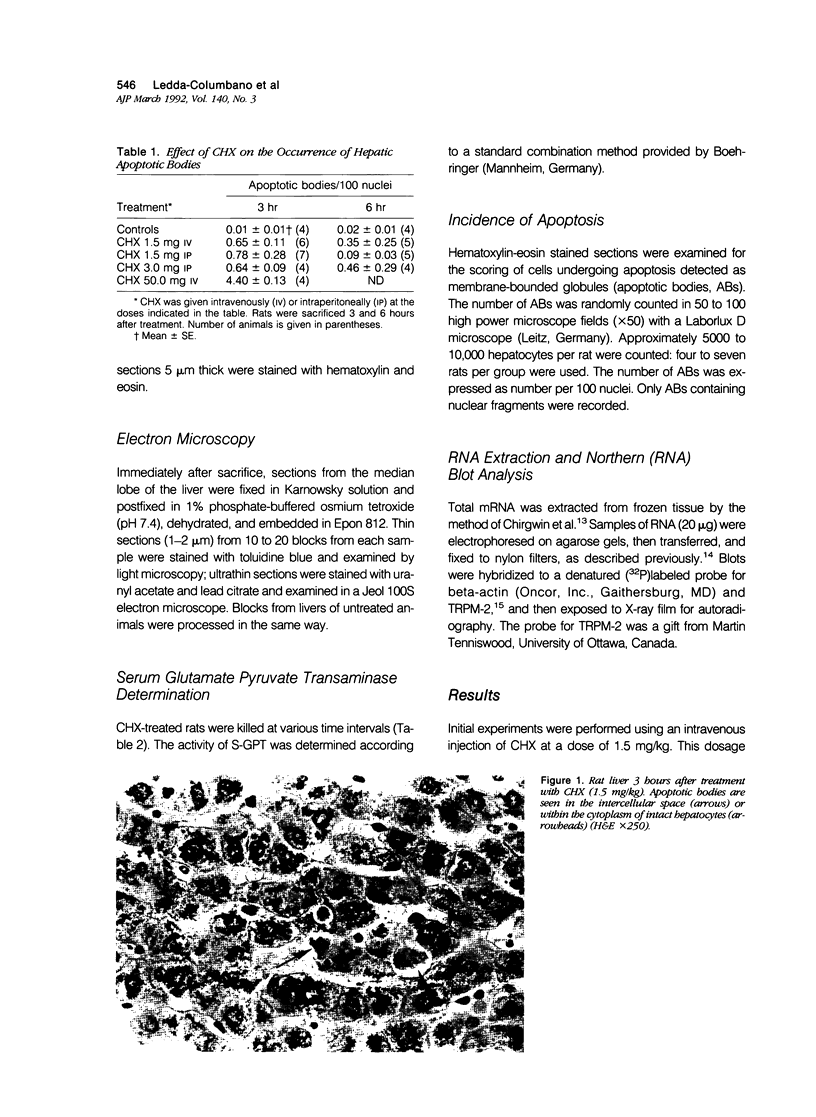
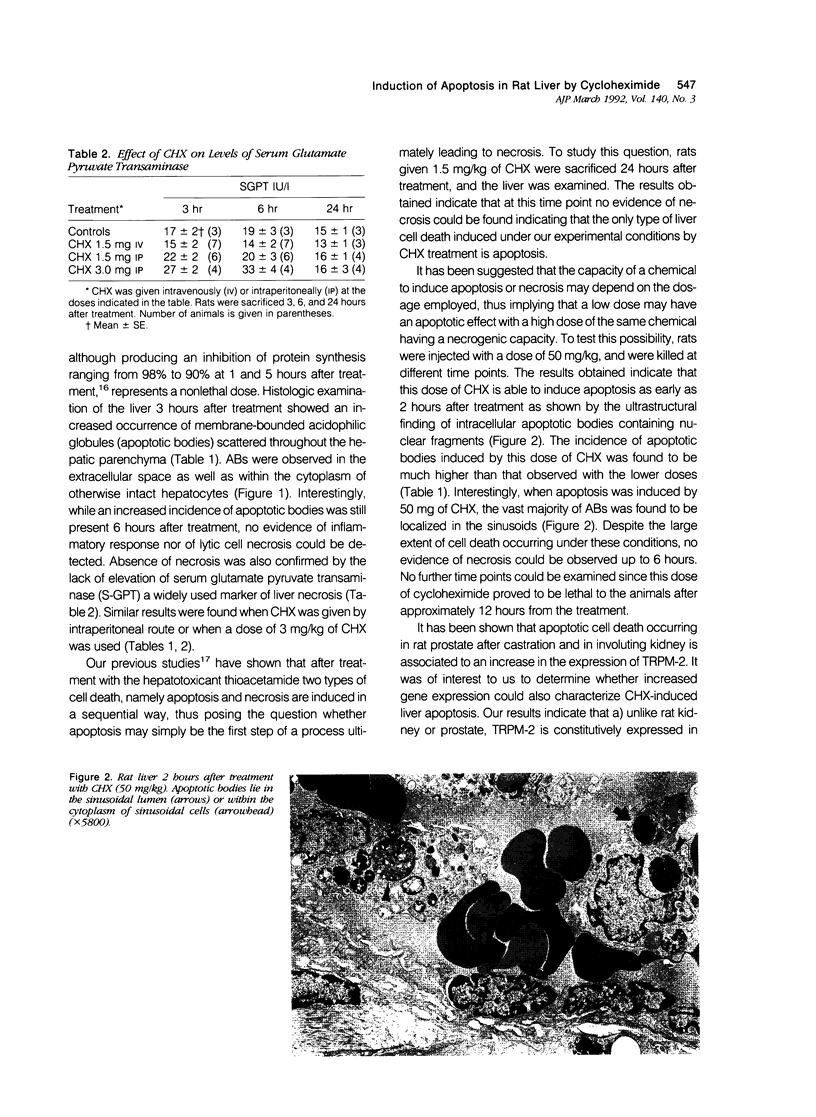
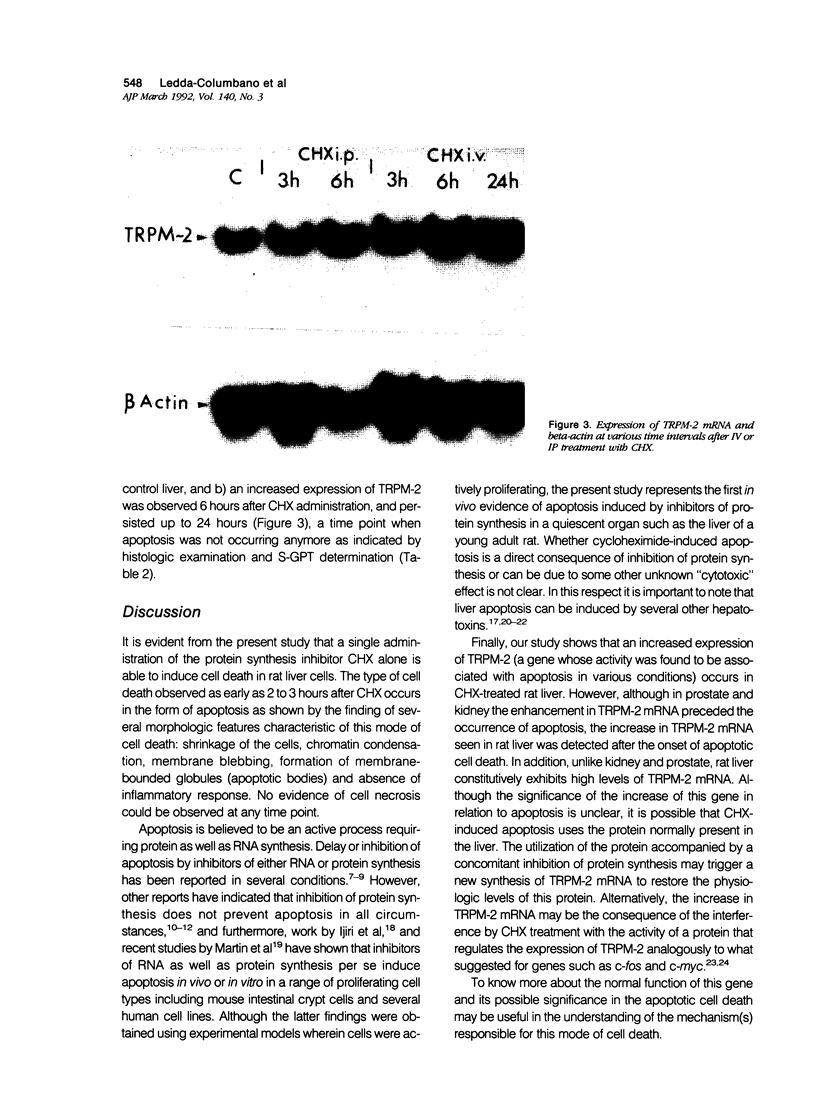
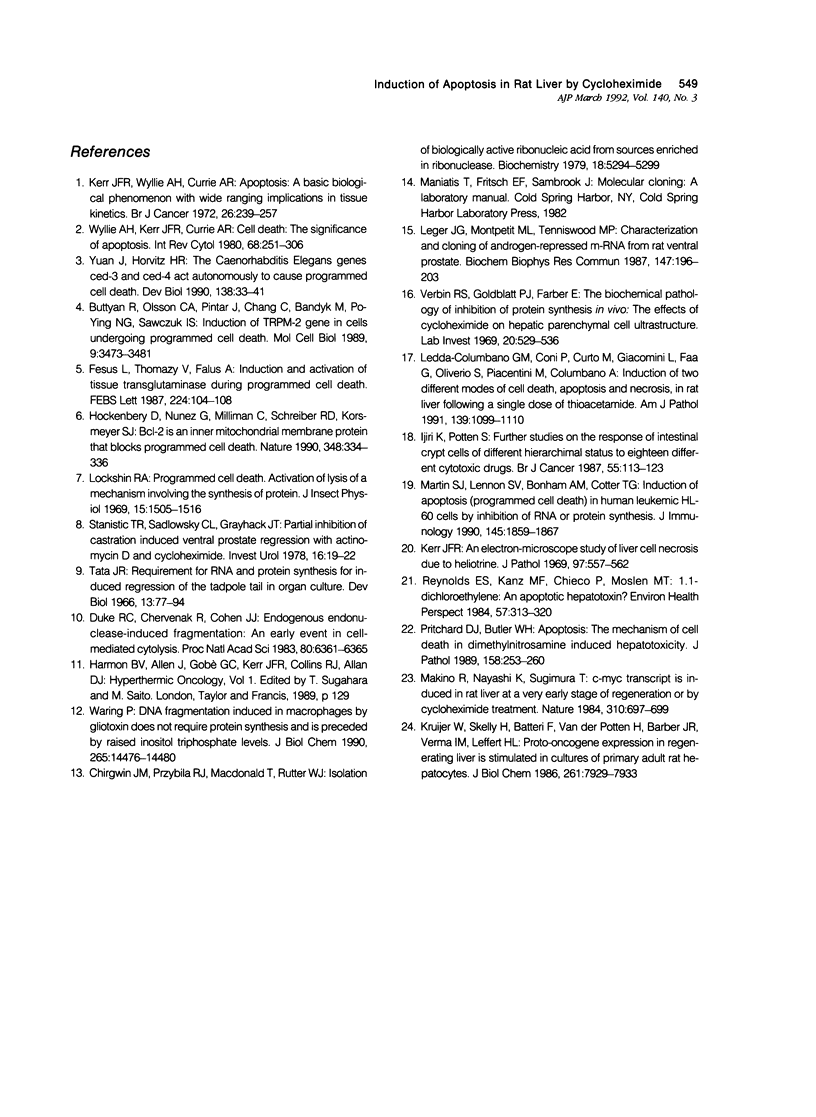
Images in this article
Selected References
These references are in PubMed. This may not be the complete list of references from this article.
- Buttyan R., Olsson C. A., Pintar J., Chang C., Bandyk M., Ng P. Y., Sawczuk I. S. Induction of the TRPM-2 gene in cells undergoing programmed death. Mol Cell Biol. 1989 Aug;9(8):3473–3481. doi: 10.1128/mcb.9.8.3473. [DOI] [PMC free article] [PubMed] [Google Scholar]
- Chirgwin J. M., Przybyla A. E., MacDonald R. J., Rutter W. J. Isolation of biologically active ribonucleic acid from sources enriched in ribonuclease. Biochemistry. 1979 Nov 27;18(24):5294–5299. doi: 10.1021/bi00591a005. [DOI] [PubMed] [Google Scholar]
- Duke R. C., Chervenak R., Cohen J. J. Endogenous endonuclease-induced DNA fragmentation: an early event in cell-mediated cytolysis. Proc Natl Acad Sci U S A. 1983 Oct;80(20):6361–6365. doi: 10.1073/pnas.80.20.6361. [DOI] [PMC free article] [PubMed] [Google Scholar]
- Fesus L., Thomazy V., Falus A. Induction and activation of tissue transglutaminase during programmed cell death. FEBS Lett. 1987 Nov 16;224(1):104–108. doi: 10.1016/0014-5793(87)80430-1. [DOI] [PubMed] [Google Scholar]
- Hockenbery D., Nuñez G., Milliman C., Schreiber R. D., Korsmeyer S. J. Bcl-2 is an inner mitochondrial membrane protein that blocks programmed cell death. Nature. 1990 Nov 22;348(6299):334–336. doi: 10.1038/348334a0. [DOI] [PubMed] [Google Scholar]
- Ijiri K., Potten C. S. Further studies on the response of intestinal crypt cells of different hierarchical status to eighteen different cytotoxic agents. Br J Cancer. 1987 Feb;55(2):113–123. doi: 10.1038/bjc.1987.25. [DOI] [PMC free article] [PubMed] [Google Scholar]
- Kerr J. F. An electron-microscope study of liver cell necrosis due to heliotrine. J Pathol. 1969 Mar;97(3):557–562. doi: 10.1002/path.1710970314. [DOI] [PubMed] [Google Scholar]
- Kerr J. F., Wyllie A. H., Currie A. R. Apoptosis: a basic biological phenomenon with wide-ranging implications in tissue kinetics. Br J Cancer. 1972 Aug;26(4):239–257. doi: 10.1038/bjc.1972.33. [DOI] [PMC free article] [PubMed] [Google Scholar]
- Kruijer W., Skelly H., Botteri F., van der Putten H., Barber J. R., Verma I. M., Leffert H. L. Proto-oncogene expression in regenerating liver is simulated in cultures of primary adult rat hepatocytes. J Biol Chem. 1986 Jun 15;261(17):7929–7933. [PubMed] [Google Scholar]
- Ledda-Columbano G. M., Coni P., Curto M., Giacomini L., Faa G., Oliverio S., Piacentini M., Columbano A. Induction of two different modes of cell death, apoptosis and necrosis, in rat liver after a single dose of thioacetamide. Am J Pathol. 1991 Nov;139(5):1099–1109. [PMC free article] [PubMed] [Google Scholar]
- Lockshin R. A. Programmed cell death. Activation of lysis by a mechanism involving the synthesis of protein. J Insect Physiol. 1969 Sep;15(9):1505–1516. doi: 10.1016/0022-1910(69)90172-3. [DOI] [PubMed] [Google Scholar]
- Léger J. G., Montpetit M. L., Tenniswood M. P. Characterization and cloning of androgen-repressed mRNAs from rat ventral prostate. Biochem Biophys Res Commun. 1987 Aug 31;147(1):196–203. doi: 10.1016/s0006-291x(87)80106-7. [DOI] [PubMed] [Google Scholar]
- Makino R., Hayashi K., Sugimura T. C-myc transcript is induced in rat liver at a very early stage of regeneration or by cycloheximide treatment. Nature. 1984 Aug 23;310(5979):697–698. doi: 10.1038/310697a0. [DOI] [PubMed] [Google Scholar]
- Martin S. J., Lennon S. V., Bonham A. M., Cotter T. G. Induction of apoptosis (programmed cell death) in human leukemic HL-60 cells by inhibition of RNA or protein synthesis. J Immunol. 1990 Sep 15;145(6):1859–1867. [PubMed] [Google Scholar]
- Pritchard D. J., Butler W. H. Apoptosis--the mechanism of cell death in dimethylnitrosamine-induced hepatotoxicity. J Pathol. 1989 Jul;158(3):253–260. doi: 10.1002/path.1711580314. [DOI] [PubMed] [Google Scholar]
- Reynolds E. S., Kanz M. F., Chieco P., Moslen M. T. 1,1-Dichloroethylene: an apoptotic hepatotoxin? Environ Health Perspect. 1984 Aug;57:313–320. doi: 10.1289/ehp.8457313. [DOI] [PMC free article] [PubMed] [Google Scholar]
- Stanisic T., Sadlowski R., Lee C., Grayhack J. T. Partial inhibition of castration induced ventral prostate regression with actinomycin D and cycloheximide. Invest Urol. 1978 Jul;16(1):19–22. [PubMed] [Google Scholar]
- Tata J. R. Requirement for RNA and protein synthesis for induced regression of the tadpole tail in organ culture. Dev Biol. 1966 Feb;13(1):77–94. doi: 10.1016/0012-1606(66)90050-9. [DOI] [PubMed] [Google Scholar]
- Verbin R. S., Goldblatt P. J., Farber E. The biochemical pathology of inhibition of protein synthesis in vivo. The effects of cycloheximide on hepatic parenchymal cell ultrastructure. Lab Invest. 1969 Jun;20(6):529–536. [PubMed] [Google Scholar]
- Waring P. DNA fragmentation induced in macrophages by gliotoxin does not require protein synthesis and is preceded by raised inositol triphosphate levels. J Biol Chem. 1990 Aug 25;265(24):14476–14480. [PubMed] [Google Scholar]
- Wyllie A. H., Kerr J. F., Currie A. R. Cell death: the significance of apoptosis. Int Rev Cytol. 1980;68:251–306. doi: 10.1016/s0074-7696(08)62312-8. [DOI] [PubMed] [Google Scholar]
- Yuan J. Y., Horvitz H. R. The Caenorhabditis elegans genes ced-3 and ced-4 act cell autonomously to cause programmed cell death. Dev Biol. 1990 Mar;138(1):33–41. doi: 10.1016/0012-1606(90)90174-h. [DOI] [PubMed] [Google Scholar]





